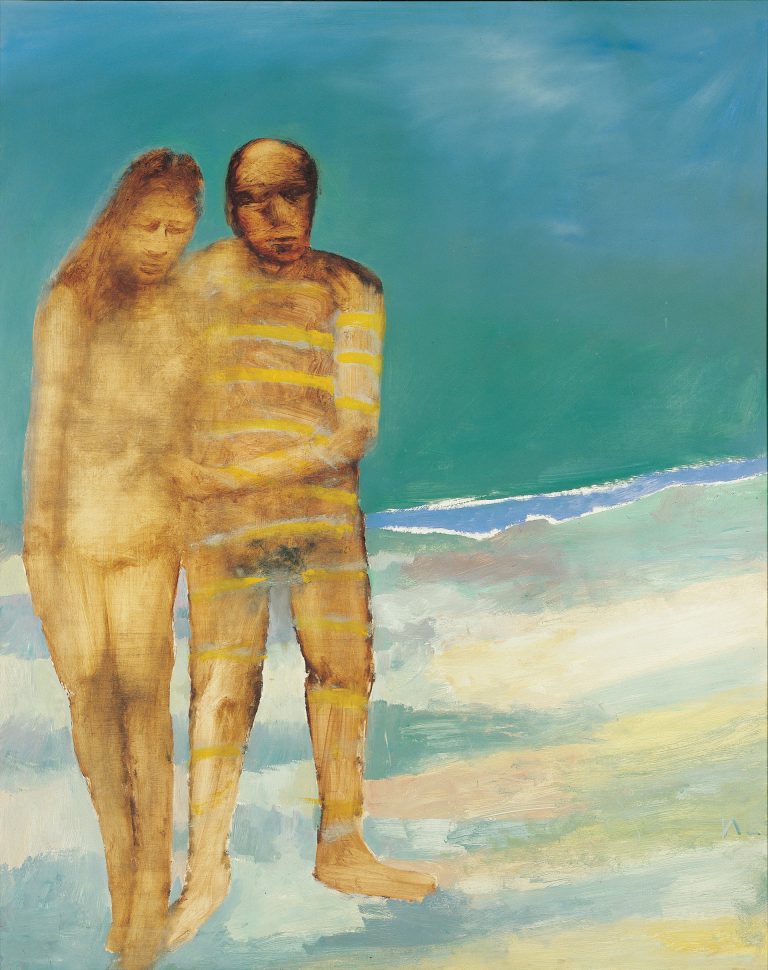We acknowledge the Traditional Owners of the land on which the Queensland Art Gallery | Gallery of Modern Art stands and recognise the creative contribution First Australians make to the art and culture of this country.

Sidney Nolan / Australia/England 1917–92 / Mrs Fraser and convict 1962–64 / Oil and enamel on composition board / 151 x 121cm / Purchased 1988 with the assistance of David Jones Australia (Queensland Division) and Sir Sidney Nolan to mark the company’s 150th anniversary, through the Queensland Art Gallery Foundation / Collection: Queensland Art Gallery | Gallery of Modern Art / © Courtesy of the Artist’s Estate
Sidney NolanMrs Fraser and convict 1962–1964
Not Currently on Display
During a visit to the John Oxley Library in Brisbane in 1947, Sidney Nolan became intrigued by the story and mythology of Englishwoman Eliza Fraser.
Eliza was on board her husband’s brig, the Stirling Castle, when it was shipwrecked off the Queensland coast in 1836. The survivors, including Eliza and her husband James, were washed ashore on Fraser Island, the country of the Badtjala people. History records her capture by local Aborigines, who speared her husband, and tells of her rescue six weeks later by the convict John Graham. Fraser’s stories of brutish savages without culture is contested by many who recognise her accounts as critical to the brutal suffering incurred by the Badtjala people, who are said to have saved her from certain death.
Eliza Fraser’s traumatic tale, along with her controversial return to England, appealed to Nolan’s preoccupation with the archetype of an outsider in a hostile environment. He went on to produce 12 landscapes that represented the narrative, a body of work which affected his painterly imagination for many years.
In 1962, Nolan returned to the theme in Mrs Fraser and convict, an example of his placement of historic and mythic figures within distinctly Australian landscapes. Nolan was influenced by Robert Gibbings’ 1937 account of the convict John Graham’s experience. In this version of the tale, Graham was the convict who rescued Eliza Fraser and led her to freedom.
Born in 1917, Sidney Nolan lived with his family in an Irish-Australian enclave in Melbourne. After leaving school, he began a part-time art correspondence course, and in 1934, he attended evening drawing classes at the National Gallery of Victoria Art School.
Nolan believed that the emotional potency of mythology can add resonance to the facts of history. Across his body of work, he experimented with size and technique, returning to the formal task of positioning a focal subject within a context and in front of a background.
His first solo exhibition, a series of abstracts and collages, was held in 1940. Between 1942 and 1945, Nolan served in the Australian Army, guarding stores in western Victoria, where he began painting outback landscapes.
He first depicted bushranger Ned Kelly in early 1945. The following year, he was discharged in absentia after failing to return to service following a month’s leave. Nolan ventured to Queensland in July 1947, spending several weeks visiting Brisbane and Fraser Island.
In 1950, he left for England, and in 1957, he was recognised with a retrospective at London’s Whitechapel Gallery. Nolan had more than 70 solo exhibitions and was knighted in 1981.
Discussion Questions
When you think of an Australian convict, what adjectives come to mind? Now think of a close friend and list adjectives to describe this person.
Classroom Activities
An artist makes decisions about what sort of background to include in a portrait. Using your imagination, create a suitable background and paint a full-body portrait of a friend in the mid-ground.